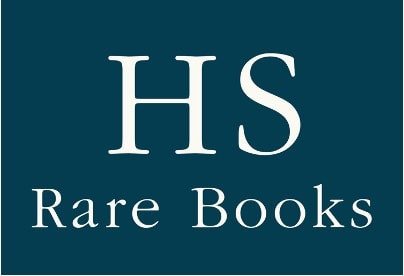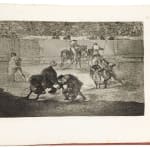






Goya y Lucientes, Francisco de
First edition, the rarest of Goya's suites of plates, created between 1814 and 1816 and focusing on the drama involved in bullfighting, and a noteworthy copy, owned by one of the most important figures of the art world of Spain of the first half of the 19th century and one of the first Goya admirers, Valentin Carderera, who here presents it as a gift to another relevant figure of Europe´s cultural world, Theophile Gautier, one of Goya's first admirers in France.
Further images
Oblong folio, (420 x 294 mm). Title and index of plates printed on a fine laid paper with Bartolome Mongelos´ watermark providing explanations on the subjects treated and the characters represented, 33 original etchings, aquatints and drypoints by Francisco Goya printed on thick laid paper. Plates 5, 8, 9, 12, 14, 15, 19 have the Morato watermark, plates 24 and 26 have watermark N°1, the rest is on identical paper but without watermark. Contemporary red morocco backed cloth, spine with raised bands and lettered in gilt, lightly rubbed. Excellent example, very clean with fine impressions, only marginal inconsequential foxing; slightly cropped by binder, tiny hole due to a lack of paper on plate 22 (2 mm), a few very pale small spots in the margins of some plates (22, 23, 25), pale damp not affecting the image in the lower right corner from pl. 21, small repaired tear in the margin of pl. 19 well away from image, excellent example.
In this superb series devoted to bullfighting, Goya expresses his great knowledge of this typically Spanish art which he practiced with passion in his youth. It is, as all of his work, a vivid representation which brings the beholder in connection with the event portrayed. Like no one before him, he painted with vivacity and power the fight between man and bull, presenting the origin and history of bullfighting in Spain followed by the prowess of some of his contemporaries such as Martincho, Pedro Romero and others.
Goya in his Tauromaquia displays his “masterly ability to portray movement, to capture the tense excitement and muscular vitality of the corrida, and this with an enerring sense of when to play with chiaroscuro effects, in the Baroque manner, to suggest the tragedy and cruelty that accompany the fateful encounter of man and beast” (Sanchez and Gallego, Goya: The complete etchings and lithographs, New York, 1995).
The series commences with the origins and history of bullfighting and works its way to the acrobatic feats of Martincho, a famous character for his stunts.
This copy is particularly important because of its provenance, Carderera was not only a famous personality in the Spanish cultural world, he was also Goya´s first great admirer, and played an essential role in the preservation of Goya's work, which is clearly highlighted by Tomás Harris: “That Goya’s drawings and engravings were not lost or entirely scaterred outside Spain is due to three facts: that Goya gave a vast number of his works to his great friend the connoisseur and historian, Juan Agustín Ceán Bermúdez; that another large part of his production was stored away by his son Javier on his departure for France, and these two groups were later united in the collection of Valentín Carderera y Solano (...) He was an ardent admirer of Goya (.. .) During his lifetime Carderera amassed a vast collection of paintings, drawings and engravings, and he possessed at one time some four hundred of Goya's drawings, two hundred and seventy-two of which were acquired by the Prado Museum in 1886, as well as the greatest collection of his engraved work ever to have been formed” (T. Harris, I, p. 11)
Goya's work first found its greatest echo in France. Already, Vivant Denon had a first edition of the Caprichos brought back from Spain under the Empire. The copy was acquired by the BNF, becoming the first engraved work by Goya to enter a public collection in France. Carderera, author of one of the first texts published on Goya in 1835, was the great propagator of the Spanish painter in France. His recently published travel diaries testify to his incredible activity as an apostle. Carderera was a familiar of Mérimée. He knew Charles Blanc, editor of the Gazette des Beaux-Arts, Philippe Burty, who translated his article and collected Goya with fervor, or the artist Achille Devéria who became Director of the Department of Prints at the BnF in 1849, not to mention the first Goya specialists: Eugène Piot, Paul Lefort and Charles Yriarte.
Valentín Carderera's travel diaries give the precise date of the present of this copy to Théophile Gautier, during a visit that the Spanish painter paid him, on Sunday, November 13, 1859. Gautier had previously published an article in La Presse on Goya's Caprices (July 5, 1838). In 1842, a decisive event for Goya's reception in France, Gautier gave a famous preface to the first catalog of Goya's engraved works published by Eugène Piot, strongly advised by Valentin Carderera (Le Cabinet de l'amateur et de l'antiquaire). For Gautier, Goya is the last Spanish painter before the decadence of Iberian painting in the 19th century: “Francisco Goya y Lucientes peut être appelé à bon droit le dernier peintre espagnol (...) il est le petit-fils encore reconnaissable de Velazquez. Après lui (...) la décadence est complète, le cycle de l’art est fermé. Qui le rouvrira?” (p. 337). Today the answer is known: Picasso. From that date, Théophile Gautier knew of the Caprichos and also La Tauromaquia: “Goya était un aficionado consommé, et il passait une grande partie de son temps avec les toreros. Aussi était-il l’homme le plus compétent du monde pour traiter à fond la matière (...) Goya a répandu sur ces scènes ses ombres mystérieuses et ses couleurs fantastiques” (p. 344). We can therefore only recognize the importance of the rediscovery of this copy, material proof of the successful dissemination of Goya's work.
Harris, Goya, Engravings and lithographs, 1983, t. II, pp. 307-310; Delteil 224-256; P. Fayos-Pérez, “Valentín Carderera and the dissemination of Goya’s graphic work in France”, Burlington Magazine, déc. 2020, pp. 1048-1055; Théophile Gautier, “Franco Goya y Lucientes”, Le Cabinet de l’amateur et de l’antiquaire, 1842, I, pp. 337-345, préface à la publication par E. Piot du premier “Catalogue raisonné de l’œuvre gravé de Franco Goya y Lucientes” (pp. 346-366).
Provenance: Valentin Carderera, who presents it as a gift to Theophile Gautier, manuscript inscription on flyleaf: “La Tauromaquia by F. Goya a M. Theophil Gauthier (sic) en prueba del mas distinguished aprecio Su admirador Valentin Carderera”; Theophile Gautier, a celebrated French writer, poet and figure of the art world, (engraved ex-libris dated 1872), his sale Catalogue des livres composant la bibliothèque de M. Théophile Gautier, Paris, Labitte, 1873, n° 66: “exemplaire avec envoi signé Valentin Calderera (sic)”; Jorge Ortiz Linares (1894 - 1965), Bolivian Ambassador and heir to one of the wealthiest men in the world, known as the “Tin King”, Simon Patiño, a.k.a as “The Andean Rockefeller”.
Valentín Carderera (1796-1880), famous Spanish painter, was a great collector of Goya (paintings, drawings and engravings). He was court painter to Queen Isabella II and a director of the Prado. Without him and without his work as a collector, the reception of Goya in 19th century Europe, and therefore the preservation of his works, would have been very different.
Join our mailing list
* denotes required fields
We will process the personal data you have supplied in accordance with our privacy policy (available on request). You can unsubscribe or change your preferences at any time by clicking the link in our emails.







